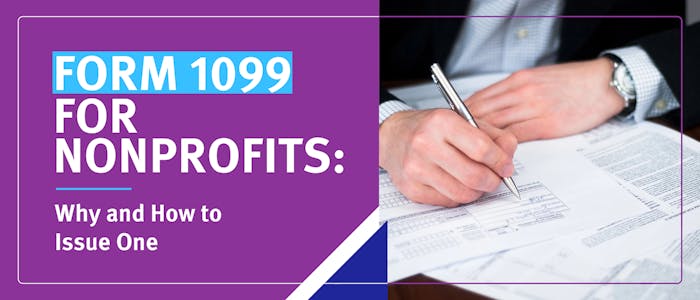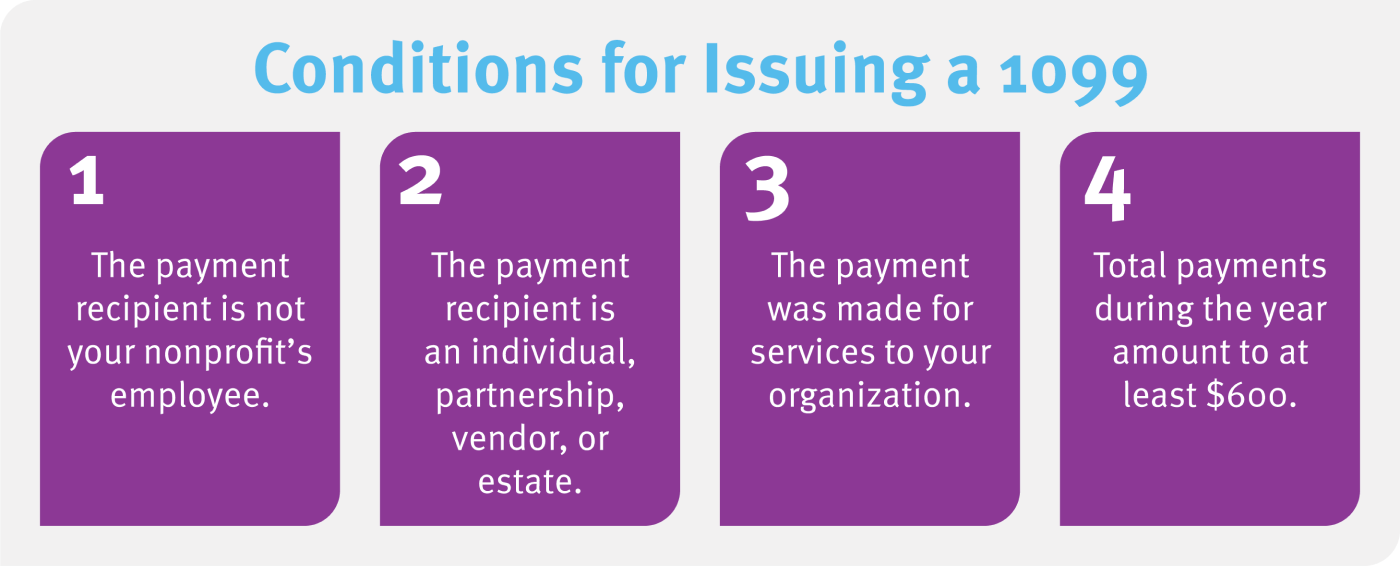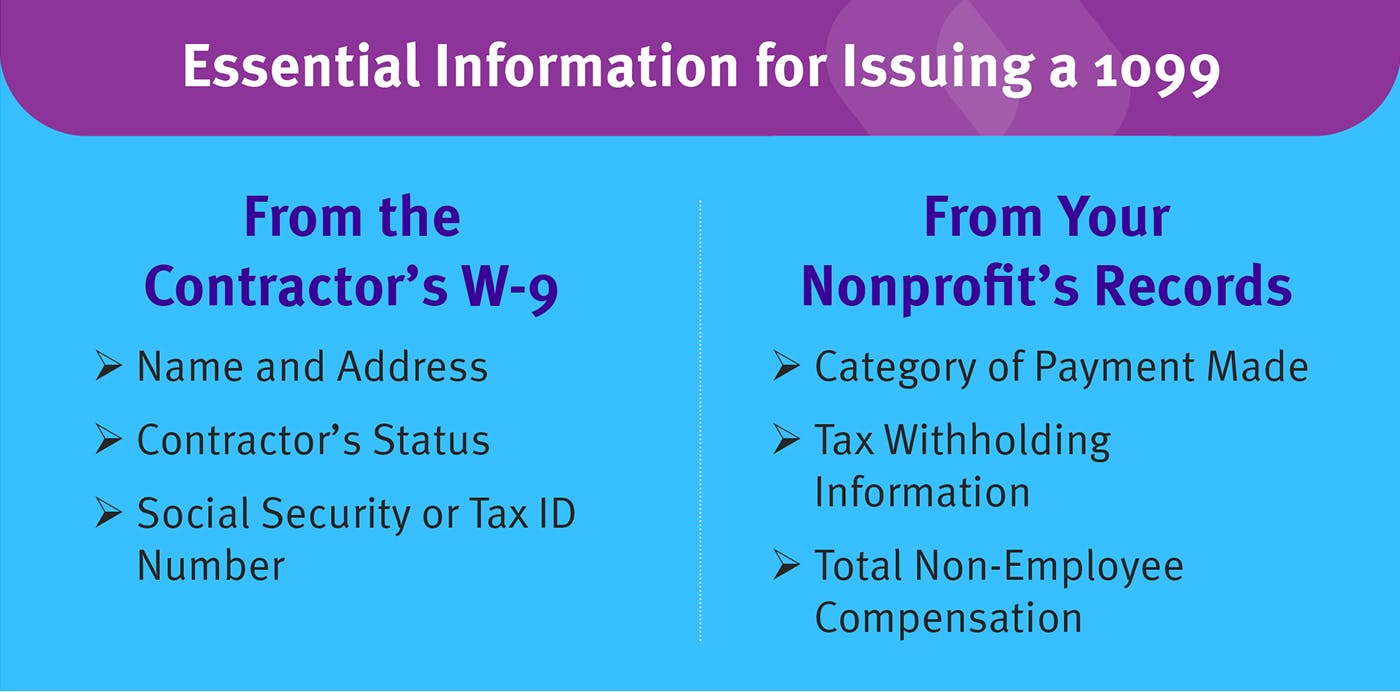
Form 1099 for Nonprofits: Why and How to Issue One
Tuesday, September 30, 2025 by Jon Osterburg

File your nonprofit's 1099s with the help of Jitasa's expert accountants.
Request a QuoteMany nonprofits have two different types of professionals working for them: employees and contractors. Employees are on your organization’s recurring payroll and have well-defined, consistent roles, while contractors provide specialized services on an as-needed basis. This role distinction not only impacts how work gets done at your nonprofit, but it also makes a big difference during tax season.
At the end of every year, you’ll provide each of your nonprofit’s employees with a W-2 to help them file their taxes. However, if you’ve hired independent contractors, you may need to issue them a 1099 instead.
In this guide, you’ll learn everything you need to know about 1099s for nonprofits, including:
- Form 1099 for Nonprofits FAQ
- Conditions for Issuing Nonprofit 1099s
- How to Fill out a Nonprofit 1099
While leveraging accounting services (like those provided by Jitasa!) saves your team time and helps ensure your organization’s forms are filled out correctly, it’s still important for you as a nonprofit professional to know what these forms are and how they’re used. Let’s dive in!
Form 1099 for Nonprofits: Frequently Asked Questions
To enrich your understanding of these essential tax documents, let’s start by answering some common questions about 1099s in a nonprofit context.
What is Form 1099?
IRS Form 1099 is a federal tax form used to prepare and file income information that’s separate from wages, salaries, or tips. Nonprofits like yours need to issue this form to independent contractors and vendors who complete work for your organization and file a copy with the IRS.
There are two types of 1099s you should be aware of: Form 1099-NEC (Nonemployee Compensation) and Form 1099-MISC (Miscellaneous Information), which are both shown below. Your organization will typically use Form 1099-NEC when working with independent contractors or freelancers and Form 1099-MISC with other types of vendors. However, these forms are easily confused, so it’s best to ask an accountant if you’re unsure about which one you need to complete.

What does “contracting” mean in a nonprofit context?
Nonprofit contracting refers to partnering with an external professional who can complete projects that require specialized skills outside your existing employees’ bandwidth. For instance, you might contract a web developer to redesign and relaunch your nonprofit’s website or a construction company to renovate your facility.
Of course, hiring is essential if you want to grow your organization, but you should be strategic about when and why you hire new staff members. Recruiting, onboarding, keeping up with compensation, and retaining larger pools of employees can quickly become expensive. So, it’s best to only bring on new full-time team members when you know you have sufficient room in your budget and a large enough long-term workload for them. In the meantime, you can save money by contracting out any short-term responsibilities you need help with.
After partnering with a contractor, securely store all of the information regarding the work they did for your organization and your payments to them, as well as the W-9 they completed for you at the beginning of your relationship (more on this later!). This data will be useful if and when you need to issue 1099s.
Can my nonprofit receive a 1099 from an external party?
The short answer is yes. The long answer is that income reported on a 1099 may or may not be taxable, but the IRS needs to know about it either way.
Like any other organization, your nonprofit can act as a contractor. For example, if a new nonprofit in a similar vertical to yours is getting started, the founder might contract your organization to consult on the launch process. Or, if your facility has a space that works particularly well for hosting events, other organizations might rent it out and create contracts with you for that purpose.
If your nonprofit’s contract work meets the conditions for issuing a 1099 (more on these later, too!), the contracting organization or individual will need to provide you with one, and you’ll need to send it to the IRS along with your annual tax return. Whether it’s taxable or exempt will depend on if the IRS considers it Unrelated Business Income (UBI) or just another part of furthering your organization’s mission.
What is the nonprofit 1099 filing deadline?
The deadline for payers to complete all of their 1099s for the previous calendar year is January 31. This is because each contractor will need their 1099 to file their taxes, so the forms have to be ready well before any other individual or organizational tax deadlines.
When you purchase 1099s for your nonprofit, you’ll also find a copy of IRS Form 1096 and related instructions in the pack. This form essentially summarizes all of the 1099s your organization issues, and you’ll need to fill it out and file it with the IRS by January 31.
If your organization fails to complete its 1099s by the January 31 deadline, you can face IRS penalties that apply to each late or missing form. Here is a breakdown of the current late fees:
- $60 penalty for filing up to 30 days late
- $130 penalty for filing more than 30 days late and before August 1
- $330 penalty for filing a 1099 on or after August 1
- $660 penalty for intentional failure to file
These fees can really add up depending on how many 1099s you have to file, so make sure to complete them correctly and on time!

Dive deeper into 1099s for nonprofits in our FREE online course!
Sign UpConditions for Issuing Nonprofit 1099s
Now that you understand the basics of 1099s, the one question that may still be on your mind is when to complete one of these forms. Generally speaking, you’ll need to issue Form 1099 when the following four conditions are met:

- The payment recipient is not your nonprofit’s employee.
- The payment recipient is an individual, partnership, vendor, or estate.
- The payment was made for services to your organization.
- Total payments during one calendar year amount to at least $600.
For example, let’s say you contracted a freelance graphic designer to create marketing materials for your nonprofit’s GivingTuesday campaign. They worked for your organization from August to November of this past year, and you paid them $5,000 over that time frame. In this case, you would definitely need to file a 1099. They’re an individual who isn’t your employee, and they provided a service to your nonprofit that you paid more than $600 for in one calendar year.
Besides understanding when you should issue a 1099, it’s just as important to know when it isn’t required. Here is a non-exhaustive list of payments for which your nonprofit doesn’t need to complete Form 1099-NEC or 1099-MISC:
- Most payments to corporations (although there are always exceptions)
- Payments for merchandise, computers, storage, and similar items
- Wages paid to employees (report on Form W-2)
- Disbursements of scholarships and fellowship grants (report on Form W-2)
- Military differential wage payments made to employees while they are on active duty in the Armed Forces or other uniformed services (report on Form W-2)
- Business travel allowances paid to employees (report on Form W-2)
- Payments that fall under your expense reimbursement policy
- Cost of current life insurance protection (report on Form W-2 or Form 1099-R)
- Payments to tax-exempt trusts (IRAs, HSAs, Archer MSAs, and Coverdell ESAs), federal and state governments (including the governments of the District of Columbia and of U.S. possessions), or a foreign government
Form 1099 may seem a bit confusing at first glance, but if you follow the guidelines above, it should be easy to determine when to complete that form. (And, of course, you can always reach out for professional advice if needed!)

File your nonprofit's 1099s with the help of Jitasa's expert accountants.
Request a QuoteHow to Fill out a Nonprofit 1099
To issue 1099s properly, your nonprofit needs to accurately track all payments to contractors in your bookkeeping system. However, your organization won’t have all of the necessary information without the contractor’s input via Form W-9.

Using W-9s to Complete 1099s
IRS Form W-9 is a simple form that contracted workers fill out to provide your nonprofit with the necessary information to issue them a 1099. It also allows the IRS to match each Form 1099 your organization files to the right contractor’s tax returns. A W-9 is only one page long and typically looks like this:

On a contractor’s W-9, you can find the following information that you need for their 1099:
- Business and/or individual’s name and address
- Contractor’s tax status
- Social Security Number (for sole proprietorships and individuals) or Tax ID Number (for applicable business entities)
We recommend asking contracted workers to fill out their W-9 at the beginning of your working relationship with them to save your organization time and energy come tax season. Keep W-9s on file as long as your relationship with a contractor is active and for at least four years after filing their last 1099.
Other Information Required on a 1099
Once you’ve pulled the details you need from Form W-9, find the following information in your nonprofit’s records to finish filling out Form 1099:
- The category of the payments made to the contractor
- Federal and state tax withholding information
- The total non-employee (or miscellaneous) compensation the contractor received
While Form 1099 is fairly short, it’s important to get the details right. On top of late filing fees, there are also penalties for errors or omissions. Before getting started, take a moment to confirm that you have all of the information you need and fill in any gaps you may find.
By becoming familiar with what Form 1099 entails and why to issue one, you’ll be better equipped to maintain compliance when it comes to your organization’s contracted workers, and you might just find filing these forms a bit less taxing. However, it always helps to have experts on your side—like Jitasa’s experienced nonprofit accounting team!
For more information on filing your nonprofit’s tax forms, check out these resources:
- Form W-9 for Nonprofits: What It Is + How to Fill It Out. Dive deeper into the requirements and best practices for requesting taxpayer information from contracted workers using Form W-9.
- Nonprofit Form 990 Filing: FAQ Guide + How to Get Started. Discover everything you need to know about filing your nonprofit’s most important annual tax form—IRS Form 990.
- 12+ Top Nonprofit Accounting Firms & How to Choose One. Explore the benefits of working with an outsourced nonprofit accountant during tax season and beyond, as well as our top recommendations.

Jitasa accountants prepare 20,000+ 1099s for nonprofits every year—and we're ready to help with your organization's, too!
Request a Quote